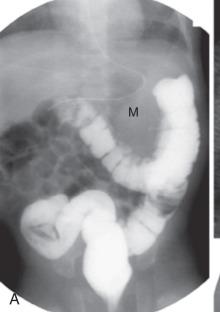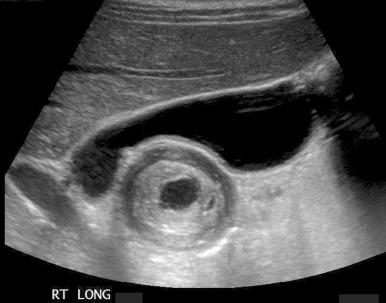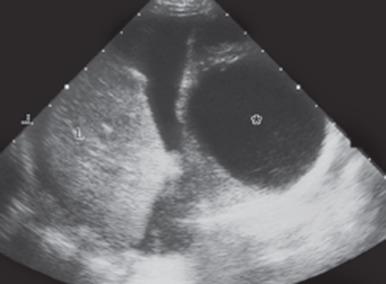Physical Address
304 North Cardinal St.
Dorchester Center, MA 02124
Congenital abnormalities of the stomach, and those manifested in the neonatal period, are uncommon and include such entities as duplication cysts, diverticula, microgastria, and anomalies involving the antropyloric region.
Duplication cysts may occur anywhere along the gastrointestinal tract, from the mouth to the rectum (see Chapter 96, Chapter 102, Chapter 105 ). Gastric duplication cysts are rare and comprise approximately 4% to 7% of intestinal duplications.
The cysts are most commonly located along the greater curvature of the stomach, share blood supply with the stomach, are invested in an outer smooth muscle layer, and typically contain gastric epithelial lining, although they may also contain pancreatic tissue or even small intestinal or colonic mucosa. More than 80% of gastric duplications are spherical rather than tubular and do not communicate with the gastric lumen. Complete duplications of the pylorus have also been described. Rarely, communication with the pancreatic ductal system has been reported.
The etiology remains controversial with several hypotheses postulated to explain the embryology of gastrointestinal tract duplications, as no single theory is sufficient to explain the characteristics of all types of duplication cysts; these theories include abortive twinning, split notochord, and persistence of an embryologic diverticulum (see Chapter 102 ).
Gastric duplication cysts occur more frequently in females at a ratio of 2 : 1. If not discovered prenatally, postnatal clinical presentation of gastric duplication cysts usually occurs during the first year of life with symptoms including intestinal obstruction, abdominal pain, palpable mass, gastrointestinal bleeding, and hematemesis or melena. Uncommon complications of gastric duplication cysts include pancreatitis and gastric outlet obstruction simulating hypertrophic pyloric stenosis when abutting the distal antrum. Malignancy has developed within the duplication cyst in some cases.
Although gastric duplication cysts may be evident on plain radiography as a masslike density in the upper abdomen, the low sensitivity and specificity limits the utility of plain radiography in the evaluation of gastric duplication cysts. Upper gastrointestinal (UGI) contrast examination may demonstrate mass effect by the cyst ( Fig. 99.1A and B ). Ultrasonography is an excellent imaging modality for characterization of these cystic masses, which often demonstrate the typical “gut signature” or “double-wall” sign representing the inner hyperechoic mucosal layer and peripheral hypoechoic muscle layers ( Figs. 99.1C and 99.2 ); free fluid may be found in cases of perforation ( e-Fig. 99.3 ). Cysts may be completely anechoic, or may contain septations and internal echoes representing proteinaceous material, blood products, or debris related to infection. Computed tomography (CT) demonstrates a well-circumscribed homogeneously low attenuating mass in the left upper quadrant. Peripheral enhancement, wall thickening, and heterogeneous attenuation of the cyst wall may be present if complicated by inflammation. On magnetic resonance imaging (MRI), the cysts exhibit fluid characteristics at T1 and T2 weighting, but the signal may increase on T1-weighted sequences in the presence of hemorrhage or other proteinaceous material. Imaging with technetium 99m-pertechnate is helpful when there is gastric mucosa lining the cysts. Meticulous technique is necessary to differentiate the duplication cyst from the adjacent stomach; multiple views may be required, and SPECT CT may be useful in defining the abnormality.



Treatment of both symptomatic and asymptomatic gastric duplication cysts entails surgical resection with complete excision of the cyst. If the cyst cannot be resected without violating the adjacent gastric lumen, a partial gastric resection with mucosal stripping may be necessary. Laparoscopic resection of gastric duplication cysts has also been described.
Gastric diverticula are rare in the general population, with a reported prevalence of 0.02% in autopsy studies and 0.04% in contrast studies. They are most commonly diagnosed in the sixth and seventh decades but are even more uncommon in children, with only 4% of gastric diverticula occurring in patients less than 20 years of age.
Approximately 70% of gastric diverticula are congenital, consist of all three layers of the gastric wall, with approximately 75% of them located in the posterior wall of the fundus 2 to 3 cm from the gastroesophageal junction. Acquired diverticula are more likely to be located near the antrum and represent false diverticula secondary to inflammatory comorbidity.
The cause of congenital gastric diverticula is thought to be related to the division of the longitudinal fibers of the wall of the stomach resulting in a defect in the musculature of the gastric wall, impacted by arterial perforators and focal absence of peritoneal investment contributing to mural weakness. Alternatively a diverticulum could result from faulty fusion of the dorsal mesentery of the stomach with the left posterior body wall. Acquired diverticula as previously noted are usually related to peptic ulcer disease or pancreatitis.
Although most gastric diverticula are clinically asymptomatic, symptomatic lesions in children tend to present in late childhood and adolescence. The symptoms can range from nonspecific complaints, such as recurrent abdominal pain, nausea, and vomiting, to massive hemorrhage and perforation; such symptoms may relate to the presence of ectopic pancreatic tissue within the diverticula causing erosions and ulceration.
Become a Clinical Tree membership for Full access and enjoy Unlimited articles
If you are a member. Log in here